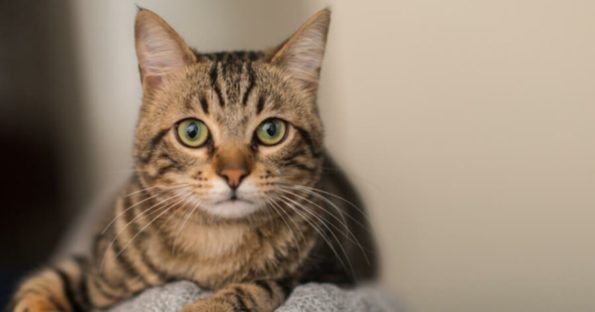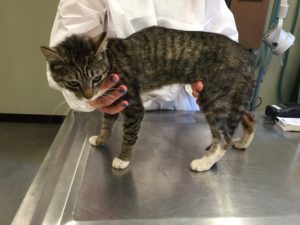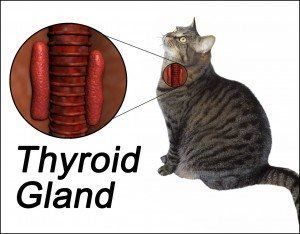
Hyperthyroidism (over active thyroid glands), is a common disease of middle –aged or older cats. Hyperthyroidism results from increased levels of thyroid hormone produced by the thyroid gland located in the cats neck. Most commonly, the gland has a non-cancerous tumour known as an adenoma, though rarely it can be as a result of a malignant tumour known as an adenocarcinoma.
Clinical Signs
Thyroid hormone has a role in maintaining underlying metabolic rate of the body and an excess of this hormone can be thought of as causing the body to run with the throttle turned up, i.e. can increase in the overall metabolism.
Clinical signs include:
- Weight loss, despite an increased and often ravenous appetite

- Increased thirst and urination
- Altered and increasingly “skittish” or hyperactive behavior
- Vomiting
- The hair often becomes unkempt and oily
- High blood pressure often results which can then in turn result in kidney deterioration and if severe, can affect the retinas and vision.
Diagnosis
A veterinarian may be alerted to the diagnosis of hyperthyroidism on the basis of the clinical history and physical examination revealing weight loss, increased heart rate, change on ocular exams and occasionally an appreciably enlarged thyroid gland palpable in the neck.
Blood testing will often reveal an increase in thyroid hormone levels but can also reveal changes in other organ systems such as the kidneys, which increases the level of suspicion. Urine analysis is performed concurrently to blood testing. Occasionally additional blood testing, to more specifically measure free thyroid hormone, is needed to establish a diagnosis.
Treatment
- Radioactive Iodine treatment
The treatment of choice is management with radioactive iodine (Iodine 131). This form of therapy has the best chance of long term control. Radioactive Iodine is given at a licensed facility. We commonly refer to Melbourne University.
Because of the radioactivity, patients are held in isolation until sufficient radioactive de cay has occurred to allow the radiation to fall to acceptable levels. This form of therapy works because iodine attaches to thyroid tissue where it is used in the product of thyroid hormone. Radioactivity is thus able to be targeted very specifically to the thyroid gland and affected tissue. Sometimes additional nuclear scanning (a pertechnetate scan) is performed to better classify location and distribution of abnormal thyroid tissue before giving radioactive iodine.
cay has occurred to allow the radiation to fall to acceptable levels. This form of therapy works because iodine attaches to thyroid tissue where it is used in the product of thyroid hormone. Radioactivity is thus able to be targeted very specifically to the thyroid gland and affected tissue. Sometimes additional nuclear scanning (a pertechnetate scan) is performed to better classify location and distribution of abnormal thyroid tissue before giving radioactive iodine. - Medication
Commonly the medication methimazzole or closely related carbimazole are prescribed (which is metabolized by the body to methamazole)
These medications block the production of thyroid hormone and manage the level of thyroid hormone in the body but does not alter the progress of the underlying disease, Medication is available for topical application to the hairless skin of the ears. The drug is usually given twice daily but can be increased. Regular blood and urine testing is recommended to ensure adequate dosage and a period of medical management with drugs is recommended to monitor for any underlying kidney changes before commencing radio-iodine treatment.

- Surgery
Surgical removal of the thyroid gland is sometimes performed. A complication of surgery is inadvertant removal or damage to the parathyroid gland which regulates calcium balance. Additionally, cats are often elderly when diagnosed with this disease and as such, there are other risks associated with general anaesthetics.



